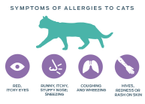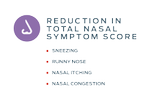

Allergies to cats impair the quality of life for cat owners and may force them to spend less quality time with their cats.
Although currently published guidelines1 recommend removing the cat from the home as a primary means of managing these allergies, this recommendation is often met with resistance because cat owners consider their cats as members of the family. Allergic cat owners often go to great lengths to find solutions that allow them to keep their cats.
Purina's research


In a crossover study using individual environmental exposure chambers, cat allergen-sensitized human participants were exposed to hair and dander from cats fed either a control diet or a test diet (control diet with added egg product ingredient containing anti-Fel d 1 IgY).
When exposed to hair and dander from cats fed the test diet, the participants showed significantly reduced Total Nasal Symptom Scores and reductions in some ocular symptoms compared to their experience when exposed to hair and dander from cats that weren’t fed the diet with the ingredient.3
This new approach, which results from more than a decade of investigation, offers allergic cat owners the opportunity to spend more quality time with their feline companions. It also offers healthcare providers an opportunity to reframe their conversations with cat-allergic patients, allowing a focus on proactive measures without the emotional toll associated with recommending the removal of a cat from the home.
Total allergen load and its role in allergies to cats
The allergen load is the total amount of allergens present in the environment at a given time, and the allergen threshold is an individual’s tolerance level for the allergen load. If the allergen load can be reduced by avoiding or reducing exposure to one or more of the contributing allergens, the cumulative level of allergen exposure may fall below an individual’s threshold and improve or prevent allergy symptoms.4

Visual representation of the impact of reducing an allergen (Allergen C) by approximately 50%. In this example, reducing Allergen C lowers the cumulative allergen load and prevents the individual from reaching their allergic threshold.
Read the review manuscript in Allergy

Related Content
Find out more about this discovery, and what this could mean for the lives of cats and the people who care for them:
Find out more
1. Dávila, I., Dominguez-Ortega, J., Navarro-Pulido, A., Alonso, A., Antolin-Amerigo, D., Gonzalez-Mancebo, E., Martin-Garcia, C., Nunez-Acevedo, B., Prior, N., …Torrecillas, M. (2018). Consensus document on dog and cat allergy. Allergy, 73(6), 1206-1222. doi: 10.1111/all.13391
2. Satyaraj, E., Li, Q., Sun, P. & Sherrill, S. Anti-Fel d 1 immunoglobulin Y antibody-containing egg ingredient lowers allergen levels in cat saliva. Submitted, Journal of Feline Medicine and Surgery.
3. Satyaraj, E., Gardner, C., Filipi, I., Cramer, K. & Sherrill, S. (2019). Reduction of active Fel d 1 from cats using an antiFel d 1 egg IgY antibody. Immunity, Inflammation & Disease. Advance online publication. doi: 10.1002/iid3.244
4. Wedner, H.J., Mantia, T., Satyaraj, E., Gardner, C., Al-Hammadi, N. & Sherrill, S. Feeding cats egg product with anti-Fel d 1 antibodies decreases environmental Fel d 1 and allergic response. Manuscript in preparation.


